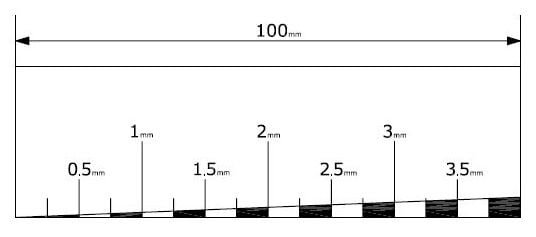
For Bass Guitar Setup, we will need a few simple tools that we can find in any hardware store. In any case, most new instruments usually come with some of these tools, such as Allen keys of different sizes, to modify truss rod and height saddles. With a screwdriver we can adjust bass intonation.
We will also need a Precision Ruler. Below you can download a template so you can make your own Precision Ruler, and it will be free.

Finally, we will need an electronic tuner, to be able for Setting Intonation of the Bass. You can use the ONLINE TUNER on website.
Important to Check Bass Guitar Nut
Many people think that their new bass will arrive perfectly calibrated, but for a variety of reasons, this is highly unlikely. Since these adjustments take time and may also depend on our personal taste. So actually the setup of a stock bass is generally pretty basic.
We would start by checking our new electric bass, starting with the nut. We will check that no string touches the first fret. If any strings are rubbing on the first fret, we would have a nut problem. In that case, the store that sold us the bass would have to take care of replacing the nut.

It is advisable to follow the calibration order shown below, so as not to have to re-adjust:
- Adjust Truss Rod
- Adjust Adjusting Action
- Setting Intonation
- Adjusting Pickup Height
Bass Guitar Setup: Adjust Truss Rod
In the event that pressing a fret of the first three a buzzing sound, it is possible that the guitar lacks some neck curvature.
This defect can be corrected by adjusting the truss rod screw, which is usually located just below the nut. This screw may be uncovered, or covered with a cap. It may also be located on the opposite side of the neck.
The truss rod is responsible for counteracting the tension exerted by the strings on the neck. Whether by excess or by defect, or depending on the string gauge mounted on our electric bass.
Although the neck cannot be completely straight, it must maintain a certain curvature. In the images some exaggerated curvatures appear so that the concept can be understood.
How To Adjust Truss Rod Bass
To give the neck a little more curvature towards the strings, we will have to turn the truss rod counterclockwise.

And to bend the neck in the opposite direction, we will have to turn the truss rod clockwise.

To Adjust the Bass Neck Truss Rod, we must loosen the strings first. Then modify the screw adjustment to the required side 1/4 turn, and re-tune again.
Then we will have to wait a few minutes to give the wood time to settle. If necessary, we tighten another quarter turn using the same procedure, without exceeding the full turn of the screw when counting the successive adjustments, or when it offers excessive resistance.
It’s a good idea to give the wood time to comfortably give. A neck can continue to give slightly for up to a couple of days after adjustment. So it’s best not to go crazy, and just go slowly.
It is very interesting to note down the adjustments we make to the Truss Rod, so that we can reverse the steps, in case we are not satisfied with the modifications. This way we can leave everything as it was before making the adjustments.
If the problems persist after a full turn of the screw, or if it offers excessive resistance, my advice is to take the bass to a professional to have it checked.
Bass With Double Truss Rod
If the electric bass model is a Double Truss Rod like the Rickenbacker models, I recommend that you take it to a luthier to have it adjusted. These models are more complex to adjust, but they have the advantage of being more stable to changes in humidity or temperature.
We can check the curvature of the neck by placing a capo on the first fret, then pressing the fourth string on the last fret. Then we measure the gap between the 12th fret and the fourth string. This space should be between 0.5 and 1.0 mm.
Bass Guitar Setup: Adjust Action Strings
The next step may be to adjust the height of the strings. This height can be modified from the saddles on the bridge, and always after loosening the strings a little.
An optimal string height for a 4-string bass would be between 2.5 and 3 mm, from the bottom of the fourth or thickest string, to the top of the 12th fret.

We can slightly lower this height towards the thin strings, and always following the curvature of the frets. For a 5 or 6 string bass the standard height would be 3mm.
There is no need to obsess over the measurements, because one or two tenths of a millimetre it will be of no use to us. The main thing is that the instrument has a good tone, is comfortable, and that the strings do not buzz when playing the bass without connecting it and in a moderate way.
Bass Guitar Setup: Setting Intonation
Another adjustment we can make from the bridge is the intonation of the bass. To do this we must ensure that the notes we play open are exactly the same as when pressing a note on the 12th fret. To be able to do this we will need an electronic tuner.
You can use the ONLINE TUNER on the website to adjust your bass’s intonation.
If on the open fourth string we have a perfectly tuned E note, and on the 12th fret we have a slightly lower E, we will have to shorten the scale, bringing the saddle closer to the pickups.

If it gives a higher E, we will have to lengthen the scale, moving the saddle of the fourth string away from the electromagnetic pickups.

As you can see, the tuner itself indicates the direction in which we should move the saddle. We would do the same with the rest of the strings, and we should always loosen the string before each adjustment.
NOTE: In the case of a change in string gauge, we would have to review all adjustments of the bass, including the intonation.
Bass Guitar Setup: Pickup Height
The measurements to Adjust the Height of the Pickups of an Electric Bass are taken from the top of the pickup pole to the bottom of the string, while pressing the last fret with your finger.
Using the precision ruler, we will check this distance, which should be between 2 and 4 mm. We should not exceed these measurements, since too much height will take away tone and volume. And little height would take away sustain as the magnet would influence the vibration of the strings, or it would simply sound bad.
A standard pickup height adjustment might be 3mm for the E string, and 2.5mm for the G string. The height can be easily changed by manipulating the screws located on either side of the pickup.

